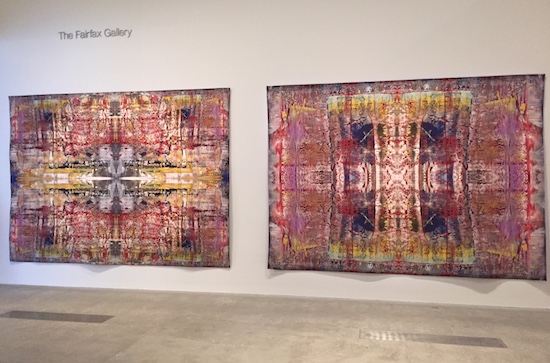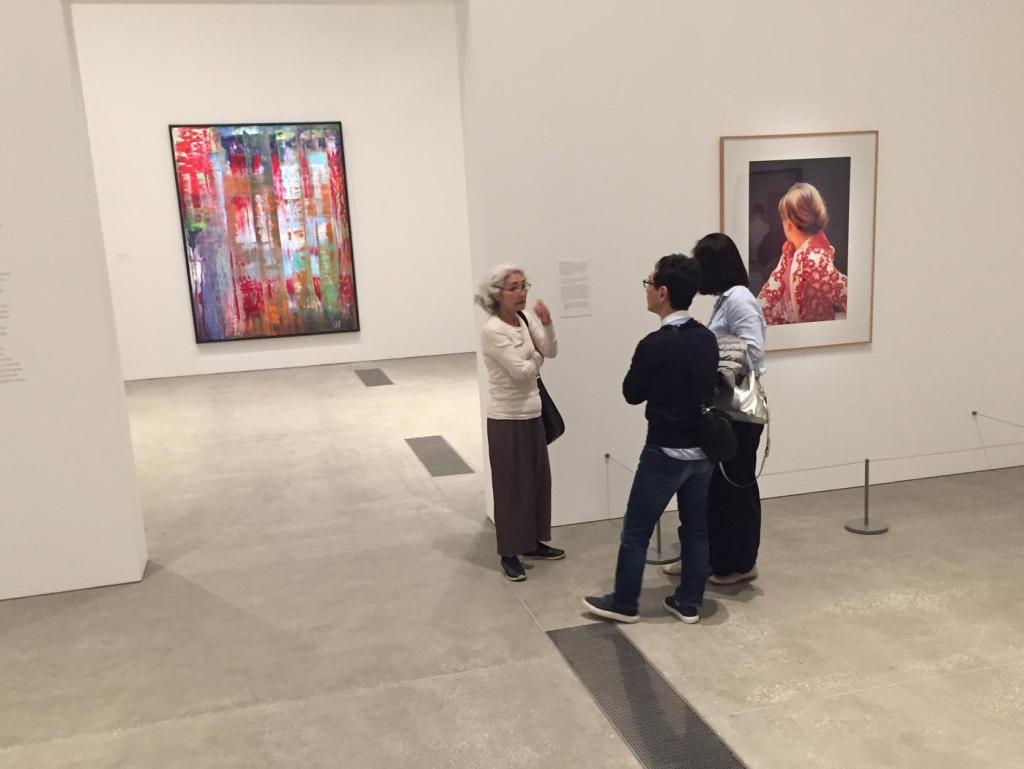Installation view: Gerhard Richter: the life of images; photo ArtsHub
At a recent dinner party, lubricated by wine, the group attending were throwing around the memories of rock concerts seen in their lifetimes – those moments where the legend meets reality, a kind of reckoning of expectations.
Gerhard Richter’s solo exhibition at the Queensland Art Gallery I Gallery of Modern Art (QAGOMA) offers that same “rock star moment”. Critics, academics and art students have been discussing Richter’s work for decades – deeply familiar with the pages of dog-eared tomes and quick to tag #fangirl – but few have seen enough of Richter’s work in one location at one time to base a true opinion.
There is little new that can be added to the conversation of Richter. Rather I am interested in the way that rhetoric and perceptions of Richter are played out in GOMA’s survey of the legendary German artist – Gerhard Richter: The life of images, curated by Dr Rosemary Hawker, Australia’s very own Richter specialist – and whether that sense of awe we have burdened Richter’s name with meets reality.
First impression is a pairing of Richter’s Ella 903-1 (2007) the iconic portrait of his daughter with Strip 927-9 (2012); installation view photo ArtsHub
First impressions
There is a grey note that sits as the foundation for this exhibition, a tone that has become the ubiquitous “gallery grey” – inoffensive, neutral and notable for its ability to make art works pop off the wall. It almost sounds bland, but in Richter’s hands he is able to imbue the hue with a whole swag of emotions and conceptual references.
He says:‘ To me, grey is the welcome and the positive equivalent for indifference, non-commitment, absence of opinion, absence of shape … it has the capacity that no other colour has to make “nothing” visible.’
This is one of many quotes scattered across the gallery walls in this exhibition of over 90 works, which on first impression feels incredibly personal and intimate.
Walking into the exhibition you start with a small “entry chamber” of sorts – a tight little room that offers a snapshot of Richter’s oeuvre: Ella 903-1 (2007) the iconic portrait of his daughter; the gyrating abstraction Strip 927-9 (2012) made from a detail of another of Richter’s paintings; a pair of small painted-over photographs, and the photographic piece, Self-portrait three times 24190 (1990).
It well be the work of four separate artists, and there in lies the enigma of Richter – bam straight off Hawker deals the card of disparity.
It is followed by a gallery of paintings dating from 1962 – 1968, all painted in a grey palette and including well-known works such as, Large pyramid 131 (1966) and Phantom interceptors 50 (1964). The tone is set – literally and metaphorically. It is referential, and self-referential; it is stylistically diverse and yet elegant, cohesive and considered.
Installation view of Large pyramid 131 (1966) and Phantom interceptors 50 (1964) at GOMA; photo ArtsHub
For those of you who know GOMA, Richter’s exhibition fills one of the large downstairs galleries – the one previously reserved for Cai Guo-Qiang’s Falling Back to Earth, Cindy Sherman’s survey and most recently, a delve into the world of Marvel – three big impact shows – and yet the scale for Richter has been pulled right back, with works displayed in intimate rooms; some so intimate that I suspect they will cause congestion around Richter’s “rockstar” moments.
Down the length of the space, running like an archival spine, is the presentation of Richter’s Atlas overview (1962-ongoing), which visitors can dip in and out of – some 400 tiny framed and marked up photographs, each with a direction relationship to the works on the walls. While it is exhaustive it offers a change of pace, but also a kind of paparazzi voyeur moment into what drives Richter, and his repeated obsessions over time.
Installation view Atlas overview at GOMA; photo Artshub
If you are considering a visit to this show based on Richter’s big hit signature works then you will be pleased to know several are present: Betty (1991) – described by the curator as one of the most reproduced images; Ema (Nude on a staircase) (1992), Reader (1994), Uncle Rudi (1965), the Birkenau paintings from 2014, Two candles (1982) – the list goes on.
Hawker said of encountering Ema for the first time at Yale University in America: ‘I was intrigued by it, irritated actually, by its blurry photographic quality,’ adding that that annoyance grew into a life-long fascination. She offers that same curiosity blurred with beauty in this exhibition.
History, it has to be said, weighs heavily in this exhibition, but it is not dealt with in the usual formulaic ways. A good example is Richter’s most recent series, the Birkenau paintings (2014). Painted from source photographs smuggled out of Crematorium V of the Birkenau extermination camp (Auschwitz), Hawker described that it was only in abstraction that Richter could best capture that history of the Holocaust.

Four tapestries hang at the conclusion of the exhibition, a surprise and revelation of the dexterity and innovation of Richter’s creative practice; photo Artshub
The attraction of Richter is his ability to transform our understanding of genres, and in that vein, the exhibition does offer surprises, in particular a suite of four large tapestries. Who knew Richter made tapestries? Although there are no sculptures included. It is a tightly curated show.
In Richter signature style, the exhibition is curated by placing an emphasis on disparate pairings – stylistically, across time, genre and scale. There is this constant bounce that keeps the eye engaged and the mind questioning. It is what Richter is perhaps most famous for – his capacity to move between scale and style indiscriminately.
Hawker, together with Geraldine Barlow, QAGOMA Curator of International Art, has been incredibly sensitive and erudite in their attention to sightlines across this exhibition, in the way a thread – of colour or energy – is picked up and flows through into the adjacent gallery. If anything, this is what I enjoyed most about this exhibition.
Is it a thumbs up?
Sherman, Richter, Kusama – there is a pattern happening here. QAGOMA is turning to bold contemporary blockbusters and – as the largest exhibition of Richter’s work to be shown in the southern hemisphere to date – The life of images is another coup for the gallery.
Still vacillating on a trip to Brisbane? Consider this. Gerhard Richter achieved the highest auction price for a living European artist for his painting, Abstraktes Bild, which fetched US$46.3 million in 2015. You might wonder why?
Richter’s art offers an important biography of our times, at times deeply personal and at others a more historic consideration. He poses an interesting thesis on how, as an artist or viewer, we can rethink history, and stereotypes of medium and genre – he is known for blatantly calling figuration and abstraction the same. It goes back to that rock concert conversation. Sometimes you just have to see the legend to understand our own opinions, and it is only in seeing that our familiarity becomes authentic.
It is a “goer” – this exhibition gives a well rounded insight into the life and work of Gerhard Richter – as best we can from this distance in Australia – and is a clear affirmation as to why he is described as one of the world’s greatest living artists.
Rating: 4 out of 5
Gerhard Richter: The life of images
Gallery of Modern Art, South Brisbane
14 October 2014 – 4 February 2018
Ticketed.








